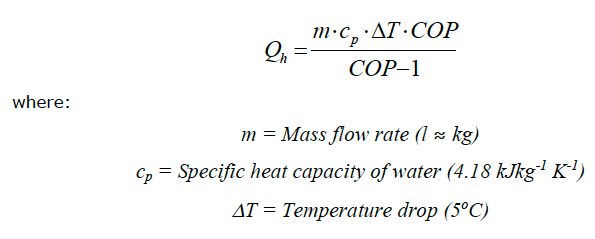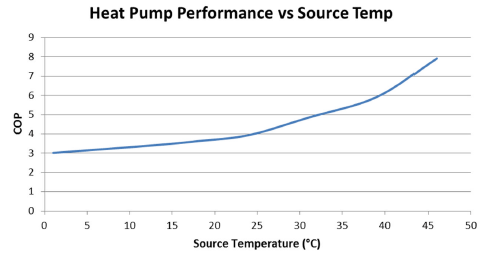Guardbridge geothermal technology demonstrator project: feasibility report
Report of the study exploring the potential of a geothermal district heating system accessing hot sedimentary aquifer resources underlying Guardbridge, Fife.
7. Geothermal Heating Potential
A traditional heat network has its extent defined either by choice or by available demand, however the extent and capacity of a geothermal-based network is mostly defined by the heating potential of the target resource. This is determined by both the source temperature, which influences the achievable temperature drop, and extraction flow rates from the resource.
7.1 Initial Estimates of Output
Before the geological work had reached its final conclusions, this heating potential was quantified for a wide range of possible values which can be seen in Table 6.1. Due to the initial assumptions around the type of geothermal resource and target depths, it was known that the temperatures found would definitely be below the typical return temperature of a district heating network ( DHN), even a low temperature network with a return of 45 °C. This meant that the only possible heating solution would be to utilise a heat pump and to upgrade the geothermal heat to the required network flow temperature. This meant that a temperature drop of 5 °C could be assumed and the potential heat output calculated for a series of flow rates and coefficients of performance ( COP's) using the following equation:

It should be noted that although the overall heat production does decrease slightly with a rising COP (Table 7.1), this is because a more efficient heat pump will draw less of its output from electricity. Given a fixed source input, this will therefore reduce the final heat output of the unit. However, the increased COP does reduce the cost of heat by a much more significant margin as can be seen to the bottom of Table 7.1. The range of COP values is based on supplier data (Fig. 7.1).
Table 7.1: Heat pump outputs for various flow rates and COP values, and the indicative cost of heat shown based on 12p/kWh for electricity.
| Heat capacity of heat pump based on T of 5 ºC (kW) |
|||||||
|---|---|---|---|---|---|---|---|
| Source Flow Rate (l/s) |
COP of Heat Pump |
||||||
| 3.0 |
3.5 |
4.0 |
4.5 |
5.0 |
5.5 |
6.0 |
|
| 5 |
157 |
146 |
139 |
134 |
131 |
128 |
125 |
| 10 |
314 |
293 |
279 |
269 |
261 |
255 |
251 |
| 15 |
470 |
439 |
418 |
403 |
392 |
383 |
376 |
| 20 |
627 |
585 |
557 |
537 |
523 |
511 |
502 |
| 25 |
784 |
732 |
697 |
672 |
653 |
639 |
627 |
| 30 |
941 |
878 |
836 |
806 |
784 |
766 |
752 |
| 35 |
1097 |
1024 |
975 |
941 |
914 |
894 |
878 |
| 40 |
1254 |
1170 |
1115 |
1075 |
1045 |
1022 |
1003 |
| Cost of Heat (p/kWh) |
4.0 |
3.4 |
3.0 |
2.7 |
2.4 |
2.2 |
2.0 |
7.2 Final Heat Production Estimates
The final temperature and flow estimates were obtained from Town Rock Energy and were given in the form of one high flow scenario that was more favourable and a low flow scenario with more conservative assumptions (Section 4.1.3). The potential heat outputs [1] of the scenarios were therefore defined as 418 kW for the high flow case and 139 kW for the low flow case.
Figure 7.1: GEA heat pump performance against source temperature, delivering at 75 oC.

Contact
There is a problem
Thanks for your feedback